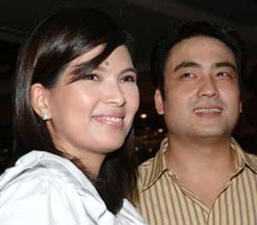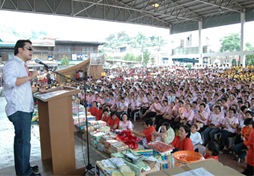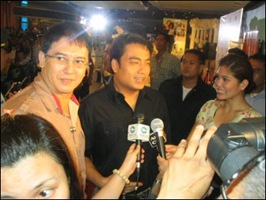 If elections were held today, Vice President Noli de Castro and former President Joseph “Erap” Estrada would hotly contest the presidency. The former broadcaster and the former actor are the top choices of voters, according to Pulse Asia’s survey of possible presidential contenders July 1 to 14, 2008.
If elections were held today, Vice President Noli de Castro and former President Joseph “Erap” Estrada would hotly contest the presidency. The former broadcaster and the former actor are the top choices of voters, according to Pulse Asia’s survey of possible presidential contenders July 1 to 14, 2008.
About 22 percent of Filipino voters would choose de Castro while 16 percent support Estrada. Despite the six percentage-point difference, Pulse Asia claims the two “are essentially tied for first place because the margin of error is plus or minus 3 percent.”
How 6 percent and 3 percent can be the same, statistically, only Pulse Asia can explain.
Meanwhile, Senators Francis “Chiz” Escudero and Loren Legarda, No. 2 and No. 1 in the 2007 senatorial elections, are the top choices for vice president. Escudero polled 25 percent while Loren 23 percent.
Again, with a 3 percent margin of error, one can say, using Pulse Asia’s phrase, both are “essentially tied for first place.” A far third is Sen. Francis Pangilinan, 11 percent.
Significantly, Chiz and Loren tied for third place as well as choices for president, with an identical 14 percent. A close fourth for president, with 12 percent, is Senate President Manny Villar.
Since the difference between 14 and 12 is just two points and the margin of error is 3 percent, one can safely say Chiz, Loren and Manny”are essentially tied” in third place, behind Noli and Erap, for president.
Since the difference between 16 (Erap’s) and 14 (Chiz and Loren’s) is 2 percent and the margin of error is 3 percent, one can again say Erap, Chiz and Loren “essentially tied”—again. Which goes to show that the 2010 presidential race remains anybody’s game.
Proof is that in terms of public satisfaction ratings, Senate President Villar enjoys a tremendous advantage over Vice President de Castro.
Villar has a net satisfaction rating—satisfied minus dissatisfied of plus 57, 17 points more than the plus 30 percent of de Castro. That’s an almost two-to-one ratio. In an election, a two-to-one performance advantage can easily wipe out de Castro’s eight-point advantage over Villar in popularity—22 percent vs. 14 percent. On the other hand, the fact that Erap placed a strong No. 2 despite his not having yet declared his desire nor “qualified” for the presidency in 2010 shows the ousted president’s continuing popularity and tremendous vote-getting power.
According to the same Pulse Asia “Ulat ng Bayan” survey, the No. 1 quality voters look for in a president is being pro-poor—39 percent, followed by can enforce the law 35 percent, and knowledgeable in management of government 34 percent. All these are attributes of Estrada whose slogan when he won the 1998 presidential race was “Erap Para sa Mahirap.”
Erap had spent over 30 years in public service, as mayor for 17 years, senator for six years, vice president for six years, and president for 30 months. Noli, on the other hand, ran for vice president after being senator for only three years.
Pulse Asia says Escudero (14 percent), Legarda (14 percent), Manuel “Manny” Villar (12 percent) and Manuel “Mar” Roxas (8 percent) “are essentially tied for second place, while the rest of the possible presidential candidates included in the list of 10 names are essentially tied for third place.”
About 4 percent of voters have no choices yet. In a close fight, 4 percent can make the difference on who eventually becomes president. Pulse Asia says results indicate that Vice President de Castro essentially maintains the voter support (21 percent) he enjoyed in March 2008.
Escudero and Legarda lead the vice-presidential race. They are tied for first place if the May 2010 elections were held today, with the former obtaining 25 percent of the votes and the latter, 23 percent. Sen. Francis “Kiko” Pangilinan, Sen. Jinggoy Estrada, Mayor Jejomar “Jojo” Binay of Makati, Sen. Ramon “Bong” Revilla, and Batangas Governor Vilma “Ate Vi” Santos are far second, with voter preferences of 5 to 1 percent.
 The passage of the freedom of information act, which can force government agencies to disclose state “secrets,” has hit a snag in the Senate.
The passage of the freedom of information act, which can force government agencies to disclose state “secrets,” has hit a snag in the Senate.




